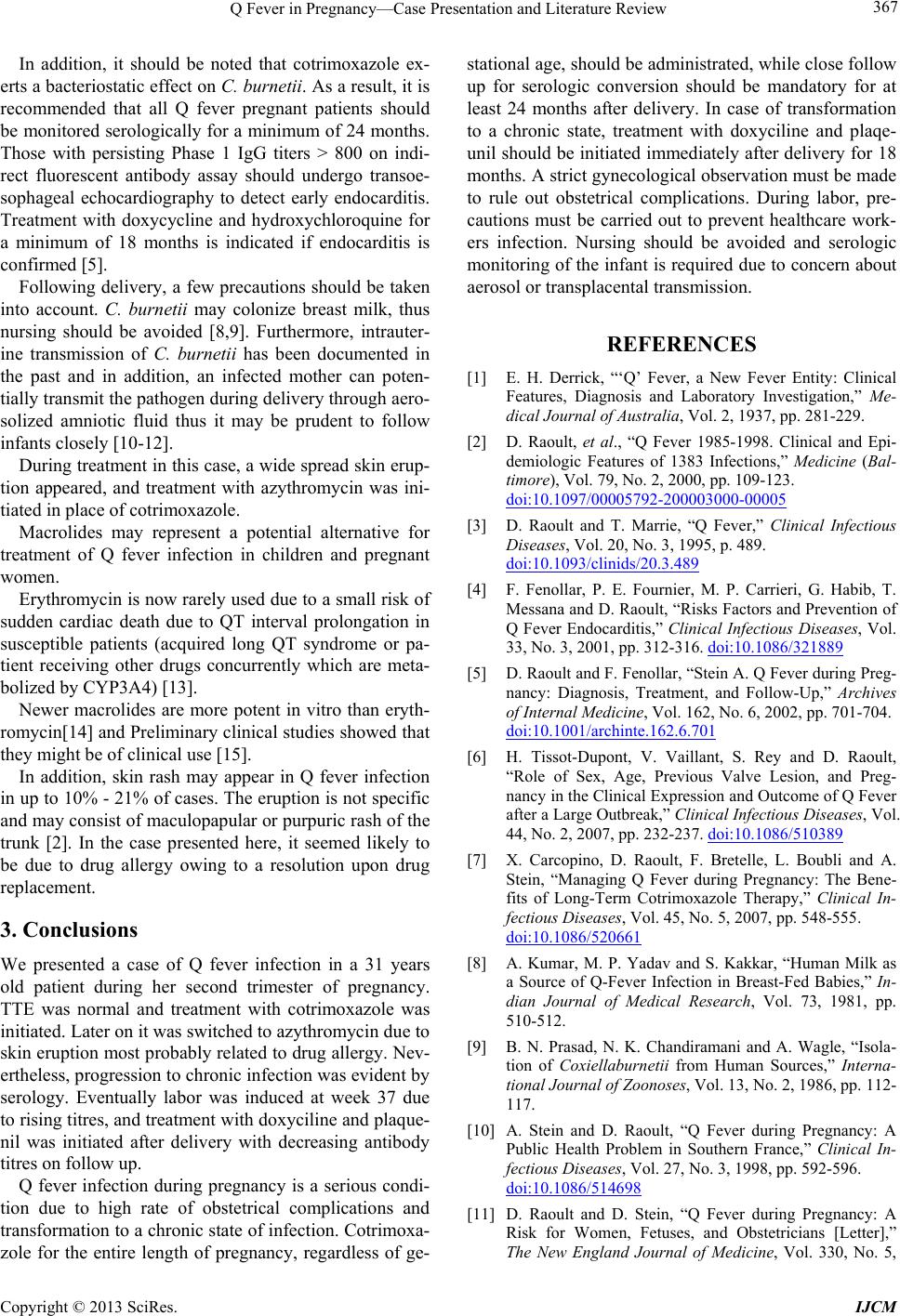
Q Fever in Pregnancy—Case Presentation and Li t erature Rev i ew 367
In addition, it should be noted that cotrimoxazole ex-
erts a bacteriostatic effect on C. burnetii. As a result, it is
recommended that all Q fever pregnant patients should
be monitored serologically for a minimum of 24 months.
Those with persisting Phase 1 IgG titers > 800 on indi-
rect fluorescent antibody assay should undergo transoe-
sophageal echocardiography to detect early endocarditis.
Treatment with doxycycline and hydroxychloroquine for
a minimum of 18 months is indicated if endocarditis is
confirmed [5].
Following delivery, a few precautions should be taken
into account. C. burnetii may colonize breast milk, thus
nursing should be avoided [8,9]. Furthermore, intrauter-
ine transmission of C. burnetii has been documented in
the past and in addition, an infected mother can poten-
tially transmit the pathogen during deliv ery through aero-
solized amniotic fluid thus it may be prudent to follow
infants closely [10-12].
During treatment in this case, a wide spread skin erup-
tion appeared, and treatment with azythromycin was ini-
tiated in place of cotrimoxazole.
Macrolides may represent a potential alternative for
treatment of Q fever infection in children and pregnant
women.
Erythromycin is now rar ely used due to a small risk of
sudden cardiac death due to QT interval prolongation in
susceptible patients (acquired long QT syndrome or pa-
tient receiving other drugs concurrently which are meta-
bolized by CYP3A4) [13].
Newer macrolides are more potent in vitro than eryth-
romycin[14] and Preliminary clinical studies showed that
they might be of clinical use [15].
In addition, skin rash may appear in Q fever infection
in up to 10% - 21% of cases. The eruption is not specific
and may consist of maculopapular or purpuric rash of the
trunk [2]. In the case presented here, it seemed likely to
be due to drug allergy owing to a resolution upon drug
replacement.
3. Conclusions
We presented a case of Q fever infection in a 31 years
old patient during her second trimester of pregnancy.
TTE was normal and treatment with cotrimoxazole was
initiated. Later on it was switched to azythromycin du e to
skin eruption most probab ly related to drug allergy. Nev-
ertheless, progression to chronic in fection was eviden t by
serology. Eventually labor was induced at week 37 due
to rising titres, and treatment with doxyciline and plaque-
nil was initiated after delivery with decreasing antibody
titres on follow up.
Q fever infection during pregnancy is a serious condi-
tion due to high rate of obstetrical complications and
transformation to a chronic state of infection. Cotrimoxa-
zole for the entire length of pregnancy, regardless of ge-
stational age, shou ld be administrated, while close follow
up for serologic conversion should be mandatory for at
least 24 months after delivery. In case of transformation
to a chronic state, treatment with doxyciline and plaqe-
unil should be initiated i mmediately after delivery for 18
months. A strict gynecological observation must be made
to rule out obstetrical complications. During labor, pre-
cautions must be carried out to prevent healthcare work-
ers infection. Nursing should be avoided and serologic
monitoring of the infant is required due to concern about
aerosol or transplacental transmission.
REFERENCES
[1] E. H. Derrick, “‘Q’ Fever, a New Fever Entity: Clinical
Features, Diagnosis and Laboratory Investigation,” Me-
dical Journal of Australia, Vol. 2, 1937, pp. 281-229.
[2] D. Raoult, et al., “Q Fever 1985-1998. Clinical and Epi-
demiologic Features of 1383 Infections,” Medicine (Bal-
timore), Vol. 79, No. 2, 2000, pp. 109-123.
doi:10.1097/00005792-200003000-00005
[3] D. Raoult and T. Marrie, “Q Fever,” Clinical Infectious
Diseases, Vol. 20, No. 3, 1995, p. 489.
doi:10.1093/clinids/20.3.489
[4] F. Fenollar, P. E. Fournier, M. P. Carrieri, G. Habib, T.
Messana and D. Raoult, “Risks Factors and Prevention of
Q Fever Endocarditis,” Clinical Infectious Diseases, Vol.
33, No. 3, 2001, pp. 312-316. doi:10.1086/321889
[5] D. Raoult and F. Fenollar, “Stein A. Q Fever during Preg-
nancy: Diagnosis, Treatment, and Follow-Up,” Archives
of Internal Medicine, Vol. 162, No. 6, 2002, pp. 701-704.
doi:10.1001/archinte.162.6.701
[6] H. Tissot-Dupont, V. Vaillant, S. Rey and D. Raoult,
“Role of Sex, Age, Previous Valve Lesion, and Preg-
nancy in the Clinical Expression and Outcome of Q Fever
after a Large Outbreak,” Clinical Infectious Diseases, Vol.
44, No. 2, 2007, pp. 232-237. doi:10.1086/510389
[7] X. Carcopino, D. Raoult, F. Bretelle, L. Boubli and A.
Stein, “Managing Q Fever during Pregnancy: The Bene-
fits of Long-Term Cotrimoxazole Therapy,” Clinical In-
fectious Diseases, Vol. 45, No. 5, 2007, pp. 548-555.
doi:10.1086/520661
[8] A. Kumar, M. P. Yadav and S. Kakkar, “Human Milk as
a Source of Q-Fever Infection in Breast-Fed Babies,” In-
dian Journal of Medical Research, Vol. 73, 1981, pp.
510-512.
[9] B. N. Prasad, N. K. Chandiramani and A. Wagle, “Isola-
tion of Coxiellaburnetii from Human Sources,” Interna-
tional Journal of Zoonoses, Vol. 13, No. 2, 1986, pp. 112-
117.
[10] A. Stein and D. Raoult, “Q Fever during Pregnancy: A
Public Health Problem in Southern France,” Clinical In-
fectious Diseases, Vol. 27, No. 3, 1998, pp. 592-596.
doi:10.1086/514698
[11] D. Raoult and D. Stein, “Q Fever during Pregnancy: A
Risk for Women, Fetuses, and Obstetricians [Letter],”
The New England Journal of Medicine, Vol. 330, No. 5,
Copyright © 2013 SciRes. IJCM